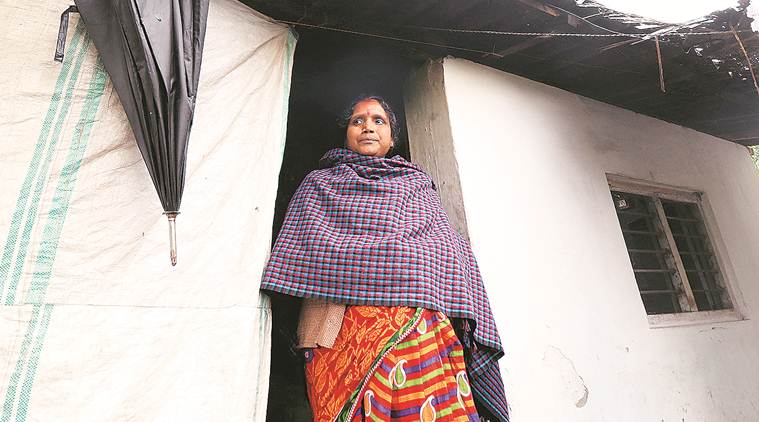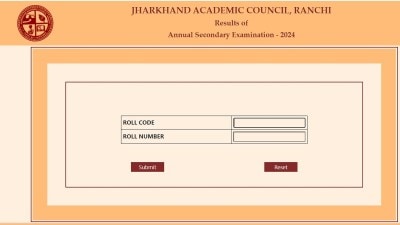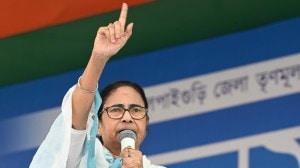- India
- International
CAA: As Uttar Pradesh begins enlisting, cheer in a Pilibhit village
Sarpanch Prashant Sana says that of Ramnagra’s population of around 4,500, “1,989” will get citizenship. “We have done a survey. We are feeding the data into an excel sheet, which will be sent to the district administration.”
 Bishuka Bishwas (35) at the house she shares with her family of six in Ramnagra village. (Express photo by Vishal Srivastav)
Bishuka Bishwas (35) at the house she shares with her family of six in Ramnagra village. (Express photo by Vishal Srivastav)
On a rainy Friday afternoon, a group is huddled around a 21-inch TV at a dimly lit tea shop in Ramnagra village, 3 km from Pilibhit Tiger Reserve. As Virat Kohli scores a boundary against the Australian cricket team, the shop erupts in loud cheers.
That’s not the only reason for celebration in Ramnagra these days. With Uttar Pradesh picking this village as among those where refugees would be given citizenship, the group at the stall expects their fortunes to change.
Sarpanch Prashant Sana says that of Ramnagra’s population of around 4,500, “1,989” will get citizenship. “We have done a survey. We are feeding the data into an excel sheet, which will be sent to the district administration.”
Subal Das, who owns the shop, migrated in 1964 from then East Pakistan with his wife; her jewellery their only possession. Serving tea, Das, now 77, says, “The situation in East Pakistan was not good. We were not safe.” His son Sameer, 30, adds, “I was born here. Then, how am I a refugee?”
Sana confirms that most of the refugees in the village are Bengali-speaking, while some are from Punjab.

According to District Magistrate Vaibhav Srivastava, a “preliminary survey” has determined where all people who migrated from East Pakistan in the 1970s are settled in the district. “Till now, we have identified around 37,000 people. This number may increase or decrease as it is a preliminary survey,” said Srivastava.
The DM says it is going to be a long process. “Documents will be collected, checked. The rules for CAA are being formulated and we will follow them once they are in place.”
Anita Roy, 36, who rolls beedis in her kuchcha house for a living, is among those hoping citizenship will change life at least for her three children, aged between 13 and 16. Roy’s name figures in Sana’s list. “I have no education, this is the only job I can do. But my children might be able to continue studies. They had to drop out as I could not afford the fees, now maybe they can get scholarship. Some people told me about this,” Roy, who was born in Ramnagra, says.
Living in the same lane as Roy, Shujitra, 51, runs a small general store plus repairs clothes. Praising the Modi government, she says, “We will get our due after more than 50 years. Till now, we could not buy land, get subsidised fertilisers or apply for a loan. It is only because of Prime Minister Narendra Modi and Amit Shah… How long could we live like this in India, where most people are Hindu?”
Madhav Das, 32, whose family also came from then East Pakistan, is helping Sana compile the list into an excel sheet at the local Jan Sewa Kendra where he works. “We have recorded names with Aadhaar numbers, voter ID details, when they came to India, the reason for their migration and if it was due to religious persecution.” Das admits that he never thought of asking his own parents their reason for leaving East Pakistan.
Prasanjit, 16, says he only got to know recently that his ancestors came from there. “I always thought we belonged to Bengal… Now they tell me I am a refugee,” he says, adding that he does not understand “big words like nagarikta (citizenship)”. The teenager, who claims he was forced to quit school after Class 4 due to “financial issues”, now helps his father at the farm where the latter works as a daily wager.
With more than three decades separating them, Prashad Sarkar, 48, a father of three, is as perplexed. “Shouldn’t I be Indian if I am born here? I have heard anyone who is born in America is an American. Is it true?”
It also worries him that he “only has Aadhaar and voter ID”. “I just hope we can prove we have been here more than 50 years,” Sarkar, who also went to school till Class 4, says.
Asked about the anti-CAA protests, Sarkar insists they are “sponsored”. “I heard on TV that opposition parties behind the protests and they are creating misconceptions as they can’t take on Modiji.”
Citizenship: The Numbers
- In 2016, the Centre empowered district magistrates and state home secretaries of seven states, Gujarat, Madhya Pradesh, Maharashtra, Rajasthan, Uttar Pradesh, Chhattisgarh and Delhi to grant citizenship to minority migrants. The states were selected as their border districts have a large number of persecuted minorities
- In July last year, MoS, Home, Nityanand Rai told the Lok Sabha tfhat since 2016, 1,310 ‘minority migrants (Hindu, Sikh, Buddhist, Jain, Parsi or Christian)’ had been granted citizenship by Rajasthan and district collectors of Jodhpur, Jaisalmer and Jaipur. 1,113 of them were granted citizenship by the Jodhpur collector
- They were given citizenship either by nautralisation (having spent at least 11 years in India) or by registration (for persons of Indian origin who have been in the country at least seven years)
- In all, 605 migrants were granted Indian citizenship in 2015, 1,106 in 2016 and 816 in 2017
- Under citizenship rules, a district collector forwards the application to the state government within 60 days and the latter is required to forward the application to the Home Ministry within 30 days
- Citizenship (Amendment) Act cuts time limit for migrants who came to India uptil December 31, 2014, to become eligible for citizenship by naturalisation to five years. This covers Hindus, Christians, Sikhs, Parsis, Buddhists and Jains from Pakistan, Bangladesh and Afghanistan, leaving out Muslims
Apr 19: Latest News
- 01
- 02
- 03
- 04
- 05






































